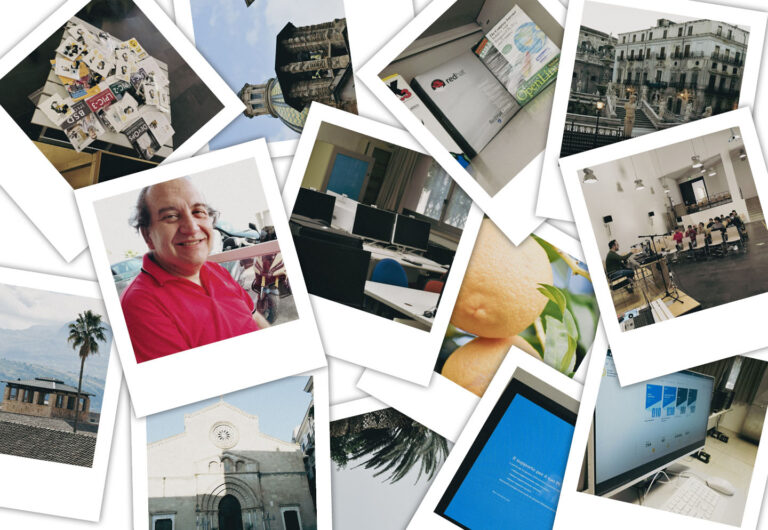Twenty-Three Years of Linux at Palermo University

At the University of Palermo, Italy, my colleagues and I have carried out an enormous conversion project from proprietary software to GNU/Linux and other free and open source technologies. This article shows how we converted nearly 100 systems and created a model for many university departments to follow.
In 2001, the first Italian Linux Day for the Palermo area was held in the main hall of the University of Palermo, organized by Sputnix in collaboration with the Centro Universitario di Calcolo Elettronico and sponsored by IBM.
We were the only Linux User Group to organize the event consistently at the university for 23 years, maintaining our recognized status as an organization by the university.
Starting Out: An Untenable Situation
In 2004, I had the opportunity to compete for a position as a system administrator at the University of Palermo. My initial assignment was in the student secretariats, where the computer system was relatively simple. It involved a Samba domain server to authenticate and manage the user folders of 90 Windows XP machines, all connected to an IBM server running RedHat 7. The domain also had several shared folders in different offices.
The majority of the machines consisted of 50 IBM PCs with 512 Mb RAM and 40GB HD. There were a few HP workstations with 1 GB RAM, also running Windows XP. The word processing system was Word 2003, with only a few users utilizing Excel, and just two users using Access 97. Additionally, there was Java student career management software on the University Computing Center server, powered by an Oracle database and Java 1.6 as the virtual machine (VM).
Frequent crashes caused by viruses plagued the system, particularly affecting one colleague who experienced crashes every 15 days. It was suspected that a virus from his home PC was infecting his work machine, rendering any remediation and prevention efforts ineffective.
None of the antivirus programs were able to withstand the massive attacks.
Taming the Chaos
To address the problem, we embarked on a step-by-step migration process. A fellow system administrator had already begun installing OpenOffice on various PCs, but it had not gained traction. Personally, on my HP DSC 1770 workstation, I utilized Fedora 15 and started converting commonly used files to the open .odt format, starting with the letterhead. I made these files available in a shared folder for everyone.
Eventually, by making code changes to IcedTea, the web launcher for the Java 6 VM, I successfully got the student careers application working. This progress indicated that we were ready for an expanded user experience.
We began the migration by selecting a few users based on personal friendship and willingness to collaborate. These initial machines were migrated to Fedora. We started by doing the installations on an ad hoc basis, but eventually established a stable version of Clonezilla, which allowed us to migrate a machine in less than half an hour.
Since all network printers were PostScript, changing the IP address of the user’s machine also facilitated changing the IP address of the already configured printer seamlessly.
As more colleagues joined in, we adopted a practice of formatting office machines infected with viruses and installing Fedora. Within a year, 40 out of 90 machines had already been migrated, significantly reducing the workload. We also acquired a queue eliminator system with 14 monitors for the counters, all running the beautiful machines with Centos 4.
After transitioning from Fedora 15 to Fedora 17, we updated Java to VM 1.7. However, it was not compatible with the student management application.
By blocking relative updates, we ensured system stability, while Windows XP machines experienced crashes whenever Microsoft, Sun, and later Oracle declared VM 1.6 as obsolete. We also blocked automatic updates of Google Chrome.
Difficulties arose for colleagues using Windows when VM 1.8 was released. Meanwhile, three years had passed, and although Windows 7 had been introduced, old machines did not support it.
I managed to order a batch of 50 Olidata machines with OpenSuse preinstalled through Mepa. However, they did not have my modified Fedora distro, named Pandora, for which I had set up a special domain, Pandoraremix.it.
Upon delivery, we did something perhaps unprecedented in a public agency: We tested each machine individually. The testing process involved turning on the machine, starting Clonezilla, and copying my distro. With two test stations working in parallel, we were able to test, reformat, and deploy all the machines in a single day.
As a result, out of 90 machines, 85 were running Fedora 17 after migration. The system was highly stable, and the migration process was almost complete.
During this time, the university started new computer labs in fields such as Medicine, Engineering, and Architecture. These labs were based on the CentOS 5 distribution, and I was transferred to start a new lab. Currently, out of 86 machines, 83 are running my customized Fedora distribution, Pandora, while only 3 are running Windows.
Proof of Effectiveness
This migration leaves the student secretariats running predominantly Fedora machines, exactly as I had configured them. Colleagues have come to appreciate the work I initiated and continued.
When examining the costs of the operation, it becomes evident that we spent nothing on software licenses, staff training, data migration, or patching to IcedTea. The only costs were our salaries and that of my colleague.
The old IBM computers that were migrated didn’t cost the agency anything, and the new Olidata computers were 90 euros cheaper because they were equipped with OpenSuse rather than a Microsoft license. The only comparison that can be made is the man-hours spent. The following table shows the time required for each major task in the migration, along with some other information.
| Service | Time, Windows/Office | Average annual recurrence (times per year) | Time, Pandora | Average annual recurrence (times per year), |
| Setup (customization and office suite included) | 2 working days | 3 | 7 minutes | 2 (related to distro’s update) |
| Backup | 3 hours | 3 | 15 minutes | 2 |
| Antivirus maintenance | 6 hours | 3 | 0 | 0 |
| Other maintenance, printering management | 1 hour | 3 | 5 minutes | 3 |
| Uninstall Java Virtual Machine | 2 hours | 3 | 0 | 0 |
| Uninstall Acrobat Reader | 2 hours | 3 | 0 | 0 |
This success proves that large-scale operating system migrations are possible.
Over the past twenty years, the University of Palermo has made significant progress in the development and utilization of Linux and open-source software. Previously, maintenance work was outsourced to external firms. However, during my tenure, we optimized time and resources, resulting in the need for only one staff unit to manage 86 machines using my customized Fedora distribution called Pandora.
Twenty years later…
In addition to the three laboratories in Medicine, Engineering, and Architecture based on the CentOS 5 distribution, other laboratories in fields such as Literature, Psychology, and Mathematics/Computer Science have emerged, utilizing Ubuntu or Fedora in dual boot with Windows 7.
The increasing awareness of Linux as a reliable operating system for high-performance computing and artificial intelligence, as demonstrated by its rankings on Top500.org, has led to its deliberate use in education, particularly for research purposes.
Linux Drives Advanced Scientific Applications
Today, the university even has laboratories dedicated to cybersecurity in the field of Computer Engineering that exclusively use the Kali Linux platform. Notably, Professor Enrico Napoli, the Vice Rector responsible for implementing the University’s Parallel Numerical Open-source Model for Unsteady flow Simulations (PANORMUS) program, has published open-source fluid dynamics libraries for research in complex hydrodynamic processes, such as river and coastal hydraulics, hydraulic infrastructures, and fluid-structure interactions. These studies employ various turbulence models within approaches using Reynolds equations and Large Eddy Simulations.
Additionally, the university has developed the PANORMUS-SPH, a fully integrated Smoothed Particle Hydrodynamics (SPH) technique for modeling incompressible fluid motion fields. They are also currently working on a hybrid Finite Volume Method (FVM)-SPH model. Furthermore, calculation codes have been developed for the study of water hammer phenomena in distribution networks, expanding the application of Linux and open-source software in various research and study areas.
